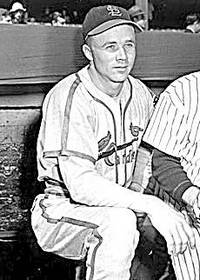

|
|
Ernie White
Date and Place of Birth: September 5, 1916 Pacolet Mills, South Carolina
Died: May 22, 1974 Augusta, Georgia
Baseball Experience:
Major League
Position: Pitcher
Rank: Corporal
Military Unit: 78th Infantry Division US Army
Area Served: European Theater of Operations
In 1936, White was signed by Pat Crawford, a St Louis Cardinals’
scout. He pitched with Asheville and Columbus in his early seasons.
Pitching for Portsmouth in the Middle-Atlantic League in 1938, he
struck out 18 in seven innings. With Houston in 1939 he was 15-7
with 149 strike outs in 189 innings. He pitched a 2-0 no-hitter
against Fort Worth.
White began the 1940 season with the St Louis Cardinals. He made
just eight appearances for a 1-1 record before being sent to
Columbus where he was 13-4 with a 2.25 ERA.
White had a superb year with the Cardinals in 1941. He was 17-7 with
a 2.40 ERA in 32 appearances.
He had 12 complete games and 117 strikeouts
In 1942 he had a 7-5 record with a
2.52 earned run average. However, he was sidelined for part of the
season with a sore arm. In the 1942 World Series, he pitched a
complete game to get the win against the New York Yankees. White was
the first pitcher since 1926 to shut out the Yankees in a World
Series game.
In 1943, he was once again troubled
with arm problems. White finished with a 3.78 earned run average and
5-5 record.
In January 1944,
White was inducted in the Army at Fort
Jackson, South Carolina. He took basic training at Fort Bragg, North
Carolina, and then moved to moved to Camp Butner, North Carolina in
May 1944 with Jake Early and Tom Livingston.
In late-1944, Corporal White was shipped overseas with the 78th
Infantry Division. He saw combat in the Battle of the Bulge and was
pinned down in icy water for a day.
In March 1945, White was one of two American soldiers who presented
arms and fired a volley over the grave of a Russian slave laborer,
in Germany.
He returned to the United States at the end of the year and joined
the Cardinals for spring training. White’s arm was still dead and he
was released by the Cardinals on May 13, 1946. He was picked up by
the Boston Braves and made 12 appearances, but was ineffective and
was released by Boston in May 1947.
White got another shot with the Braves in 1948 and made 15 relief
appearances for a 1.96 ERA. Being released for the second time by
the Braves in October 1948, marked the end of Ernie White’s major
league career.
White managed in the minor leagues for many years. He was a scout
with the Braves in 1958 and resurfaced in the majors in 1963 as a
pitching coach with the New York Mets.
Ernie White passed away at a hospital in Augusta, Georgia on May 22,
1974, following a knee operation. He was just 57 and is buried at
Pacolet Memorial Gardens.
Created June 20, 2007.
Copyright © 2008 Gary Bedingfield (Baseball
in Wartime). All Rights Reserved.


Click Here to Review Ernie White's Stats on Baseball Almanac
“Where what happened yesterday is being preserved today.”